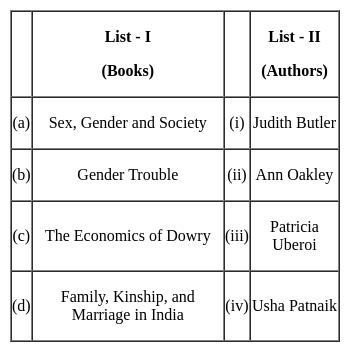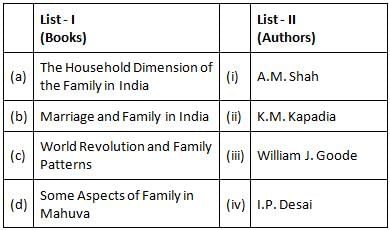UGC NET Paper 2 Sociology Mock Test - 7 - UGC NET MCQ
30 Questions MCQ Test UGC NET Mock Test Series 2025 - UGC NET Paper 2 Sociology Mock Test - 7
Which research technique would most likely be used by a symbolic interactionist?
Which one of the following refers to a relationship between a cultural group and natural environment?
With regard to the following statements, choose the appropriate answer.
Statement 1: Climate change is solely caused by human activities.
Statement 2: Natural factors, such as volcanic eruptions, have no impact on climate change.
Statement 3: The Intergovernmental Panel on Climate Change (IPCC) plays a crucial role in assessing climate science.
Statement 4: Biodiversity loss is not connected to climate change.
Which of the following could be considered as the parameters of sustainable development?
1. Carrying capacity
2. Inter and intra-generational equity and justice
3. Human development
4. Gender disparity
5. Social and cultural diversity
6. GDP of an economy
Identify the correct answer from the codes given below.
Assertion (A): The Sustainable Development Goals are the blueprint to achieve a better and more sustainable future for all.
Reason (R): The Sustainable Development Goals were set up by the Government of India in 2016
Consider the following statements and identify the right ones.
i. Green Revolution ensured that there was no regional disparity
ii. There was increase in production of all the food grains and commercial crops.
Match List - I with List - II :

Which kind of stratification system is more closed?
The political master always finds himself vis-a-vis the trained official in the position of a dilettante facing the expert. Whose opinion is this?
________ implies a value-judgement about the folkways.
Given below are two statements, one is labeled as Assertion (A) and the other as Reason (R):
Assertion (A): Gross Domestic Product (G. D. P.) growing at a higher rate is not a True indication of social development.
Reason (R): It only indicates growth in G. D. P. but not its pattern of distribution among various strata.
The process by which working-class people assume life style and individualistic values of the so-called middle classes is known as:
The second phase of the Swachh Bharat Mission (Grameen) is to be implemented till which financial year?
Given below are two statements, one labelled as Assertion (A and the other labelled as Reason (R):
Assertion (A): Both Lewis Coser and Randall Collins are grounded under the conflict school.
Reason (R): Both of them highlight the function of conflict in maintaining society.
The family in which spouses, their offspring and other relatives through marriage, live together, is called as-
According to Lester Ward, applied sociology was intended to:
Religion, family, marriage, caste, etc. are examples of:
The variable sum concept of power is based on the assumption that:
Consider the following statements:
1. India will become the third nation in the world to launch a Human Spaceflight Mission.
2. The Indian Space Research Organisation (ISRO) successfully conducted the qualification test of the Cryogenic Engine for the Gaganyaan Programme.
Which of the above statements is/are correct?
|
92 docs|125 tests
|
















